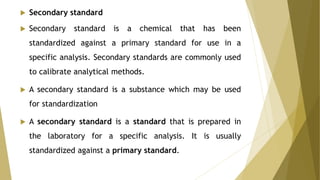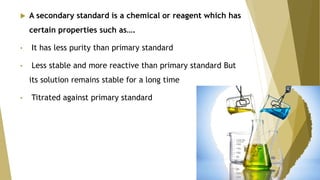Priamary & Secondary standard
- 1. Primary & Secondary Standard Presentation by, Mr. Prashant B. Patil Assistant Professor H R Patel Institute of Pharmaceutical Education and Research, Shirpur
- 2. ’üĄ Standards ’üĄ In Pharmaceutical Analysis, the word standard means a material containing a substance of our interest with a known concentration. We can express this with definite numbers with proper units. ’üĄ Functions ’ü▒ To provide a reference using which we can determine unknown concentration of solution ’ü▒ To standardization of volumetric solutions ’ü▒ Preparation of secondary standard ’ü▒ To calibrate an instrument
- 4. ’üĄ Primary Standards ’āś Primary standard is a reagent which is very pure, generally representative of the number of moles the substance contains and easily weighed. ’āś A Primary standard is a reagent thatŌĆÖs stable, itŌĆÖs not a hydrate /has no water of hydration, and has a high molecular weight.
- 5. ’āś Primary standards are typically used in titration to determine an unknown concentration and in other analytical techniques. ’āś High level of purity, low reactivity (high stability), high equivalent weight (to reduce error from mass measurements) ’āś Not hygroscopic (to reduce changes in mass in humid versus dry environments), non-toxic, inexpensive and readily available ’āś It should have a high relative molecular weight so that weighing errors may be negligible. ’āś The substance should be readily soluble under the conditions in which it is employed.
- 6. ’āś The substance commonly employed as primary standards are mention belowŌĆ” ’é¦ Acid- base reactions: sodium carbonate Na2CO3, sodium tetraborate Na2B4O7, potassium hydrogenphthalate KH(C8H4O4), potassium hydrogeniodate KH(IO3)2. ’é¦ Complex formation reactions: pure metals ( zinc, copper, magnesium and manganese) and salts, depending upon the reaction used.
- 7. ’é¦ Precipitation reactions: silver, silver nitrate, sodium chloride, potassium chloride and potassium bromide. ’é¦ Oxidation- reduction reaction: potassium dichromate (K2Cr2O7), potassium bromate (KBr), potassium iodate ( KIO3), sodium oxalate Na2C2O4 and pure iron.
- 8. ’üĄ Secondary standard ’üĄ Secondary standard is a chemical that has been standardized against a primary standard for use in a specific analysis. Secondary standards are commonly used to calibrate analytical methods. ’üĄ A secondary standard is a substance which may be used for standardization ’üĄ A secondary standard is a standard that is prepared in the laboratory for a specific analysis. It is usually standardized against a primary standard.
- 9. ’üĄ It follows that a secondary standard solution is a solution in which the concentration of dissolved solute has not been determined from the weight of the compound dissolved but by reaction (titration) of a volume of the solution against a measured volume of a primary standard solution.
- 10. ’üĄ A secondary standard is a chemical or reagent which has certain properties such asŌĆ”. ŌĆó It has less purity than primary standard ŌĆó Less stable and more reactive than primary standard But its solution remains stable for a long time ŌĆó Titrated against primary standard
- 11. ’üĄ References ŌĆó A.H. Beckett & J.B. Stenlake's, Practical Pharmaceutical Chemistry Vol I, Stahlone Press of University of London ŌĆó A.I. Vogel, Text Book of Quantitative Inorganic Analysis ŌĆó Bentley and Driver's Textbook of Pharmaceutical Chemistry ŌĆó John H. Kennedy, Analytical Chemistry Principles ŌĆó Indian Pharmacopoeia & Merck Index
- 12. Thank YouŌĆ”!!!












